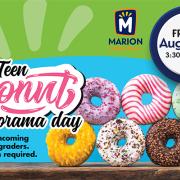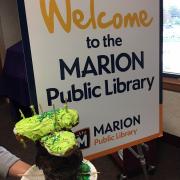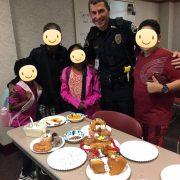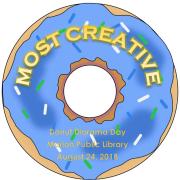In this messy, fun, hands-on program, tweens and teens dare to design and devour delicious doughnut dioramas alongside local police officers.
Using doughnuts, candy decorations and basic supplies, teams create freestanding structures that are judged in categories like creativity and engineering.
The event was designed to ease relations between local teens and police with humor and treats.
Advanced Planning
Our primary goal for this program was to build community. We had witnessed some tense teen/police officer interactions at our library and wanted to provide an opportunity for both sides to build relationships in a fun but structured, tension-free way.
Our first Donut Diorama Day was held in 2017. In March, I started researching what partnerships other libraries had built with police departments, such as storytimes (too young), panel discussions (too formal) and gaming with officers (a possibility). We wanted something more universally appealing. What is universally appealing, especially to teenagers? Food. What food is stereotypically associated with police officers? Doughnuts. I connected it to the Washington Post’s annual Peeps Diorama Contest, and Donut Diorama Day was born.
We scheduled the program for August to jumpstart the school year. I reserved our community meeting room. I also created a pre-registration form with a limit of 25 attendees and printed doughnut-shaped award certificates for winners (see Slideshow at the right).
In June, I contacted our police department, and they committed to sending officers. We also reached out to the bakery department at the local supermarket, Hy-Vee, to request a doughnut donation.
The day before the program, we purchased a variety of candy for decoration, utensils and materials for structural support, and ingredients to make frosting.
Marketing
We posted the event on our website, Facebook page, in our monthly newsletter, and in our town’s quarterly newsletter. We also promoted it by word of mouth during our summer reading program, particularly to teens who we also saw regularly during the school year.
Word-of-mouth is our biggest promotion tool: several participants are “legacies” and come back every year, recruiting family and friends to participate, too. Consistently, just over half our participants pre-register.
On the library’s social media, we’ve seen several event shares and tagging in the comments, but no robust engagement. In the future we would like to ask the police department to promote the event on Facebook, too; they have shared photos on their Facebook page after the program, and it sparked positive engagement with a different audience.
We could also benefit from including more marketing on our library’s Instagram, because that is the social media app our teens have said they follow most.
Budgeting
Most of our budget went toward purchasing candy for decorations. The doughnuts were donated, and other basic supplies (e.g., paper plates, plastic tablecloths, plastic cutlery, bowls to hold candy and frosting) we already had on hand from previous programs. We also used the staff printer and laminator to make the winners’ certificates.
One way to cut cost is purchasing ingredients to mix frosting instead of buying it premade — but do factor in staff time/cost with that method. You can also use old newspapers to cover the tables instead of tablecloths. We purchased wooden skewers our first year as structural tools, then realized we could have used our craft supply of popsicle sticks.
My biggest suggestion for cost-cutting is: don’t be afraid to ask for discounts/donations! The supermarket donated six dozen doughnuts, all free. That would have cost us over $100, but these were day-old donuts that normally would have been thrown out. We have joked about asking for a monetary donation from a local dentist’s office, with toothbrushes to hand out after the program. Why not?
Day-of-event Activity
The day of the event, we had two or three staff members helping. In the morning, it took one hour for one staff member to make frosting and another 30 minutes to print and cut out the certificates.
An hour and a half before the event, staff members rearranged our community room into clusters of tables, taped down plastic tablecloths, and poured candy into bowls. We also set out the doughnuts next to paper plates, plastic knives, plenty of napkins and baby wipes.
We wrote a couple general suggestions on the white board in case teens were stumped for ideas and needed some inspiration. We have tried specific themes (e.g. "Halloween") and general prompts (e.g. “animals,” “your favorite book or movie”) but otherwise, the only guideline is that the doughnut creation has to be freestanding.
A few teens arrived early, and they were more than happy to help with set-up.
Program Execution
Donut Diorama Day is thrilling chaos. For our 2019 event, it was 45 minutes with 25 teens and 6 police officers darting around, negotiating for more Pull’n’Peel Twizzlers and “Get me two blue M&Ms!”
We let the teens choose their teams. Some choose to work alone, but most end up in groups of two to four.
There were hands covered in frosting, doughnuts disappearing into mouths, and intense debate over diorama ideas and how to accomplish them. Our officers were fantastic at taking direction from the teens, giving suggestions, and holding and fetching more supplies for their teams as needed.
The last 15 minutes were reserved for judging by officers and library staff. Each team had to name their creation and explain to the judging panel how they had accomplished it. All the teens crowded around each other’s dioramas to listen and see what their peers had built.
At the end, we announced the winners in each category (e.g., most stable, most creative). We handed out certificates and encouraged winners and non-winners alike to (please) take doughnuts home.
Teens wanted to know when we were doing it again; a few parents came in to snap photos. We knew our goal had succeeded when one team made a doughnut version of the school resource officer, then gleefully called him over so he could watch his doughnut self be decapitated. Officer Daubs thought it was awesome.
We have not used any formal evaluation tools but consider it a success based on ad hoc feedback from participants and the police officers. The teens remember the officers at the program, and the officers remember the teens and the sculptures from previous years — proof of positive connections and relationships. In addition, it has strengthened the library’s partnership with the police department: we have been able to reach out to them in a way that is less about “reporting an issue” and more about working together to do good by our community’s teens.
We were also able to grow our partnership with a local middle school by bringing Donut Diorama Day to their library. Their media specialist saw our social media posts about the event and reached out. Forty sixth-graders and five officers crafted spooky doughnut sculptures on Halloween. Since that event, several of those teens have visited our library and recognized our staff, so Donut Diorama Day has also established new connections between teens and library services that had not existed before.
Advice
If you are concerned about how to pitch the program/volunteer request to your police department, look at their strategic plan and connect the library objectives to their community/youth engagement goals.
Logistically, prepare for mess. Cover the tables. Have plenty of wipes and/or a handwashing station nearby. Consider using food handling gloves. Schedule at least 30 minutes to clean after the program is done.
Both officers and participants will benefit from a step-by-step breakdown of what is happening when, e.g. “Brainstorming Your Diorama: 4 - 4:10 p.m.”, “Diorama Creation: 4:10 - 4:45 p.m.", “Awards Presentation: 4:45 - 5 p.m.”
Mentally, prepare for excitement. Whether or not your program will be as chaotic as ours depends on how you want to structure the teams and supplies. Consider splitting all supplies evenly between teams so everything is within reach, or encourage social and negotiation skills by having a separate supply table and allowing teams to coordinate with each other to secure the items they want to use. Even if it is delightful chaos, remember to take lots of photos of all the sculptures, officers and participants (with permission).
Emotionally, you won’t want to eat, see or smell a doughnut for at least three months post-program. Plan accordingly.






